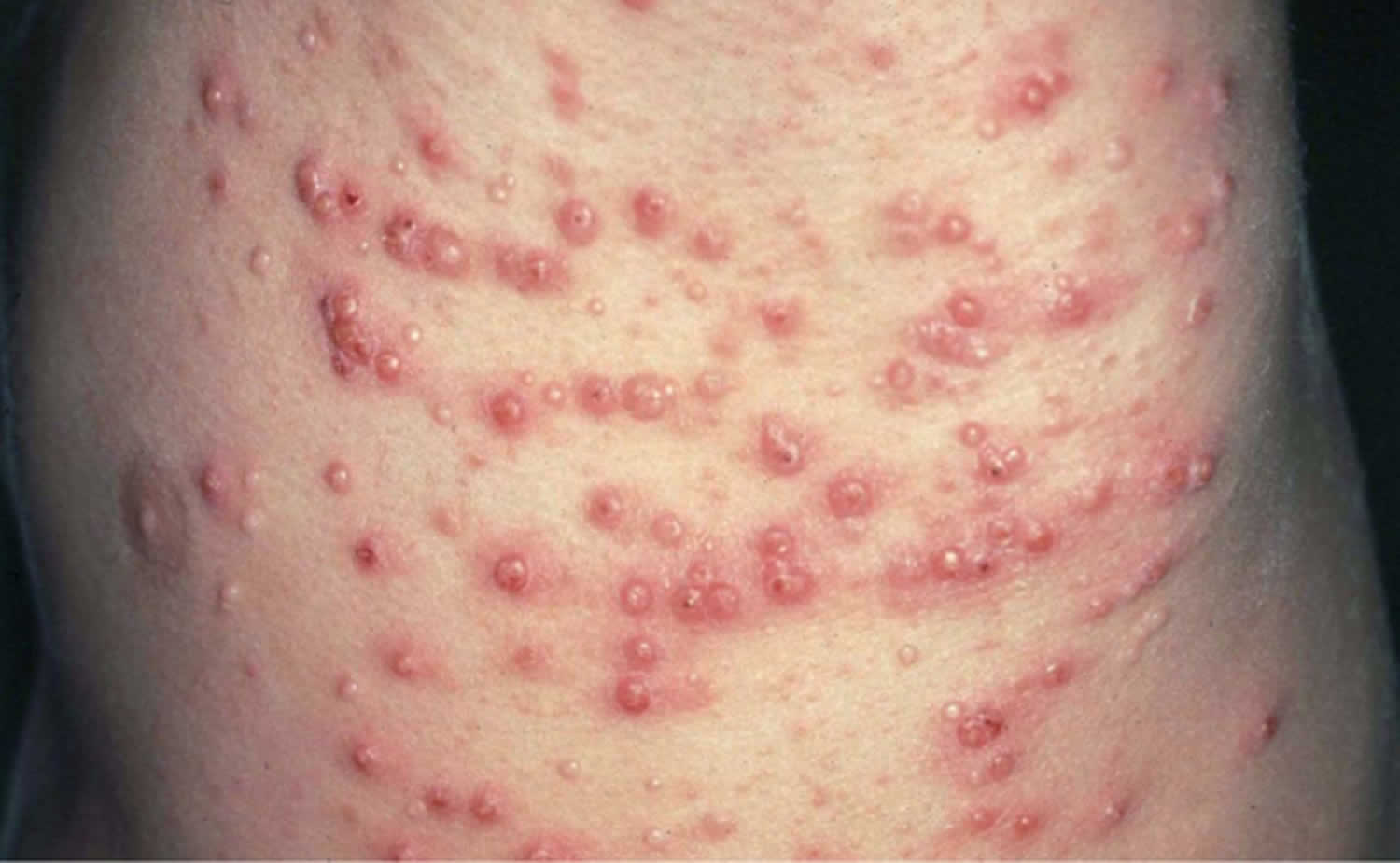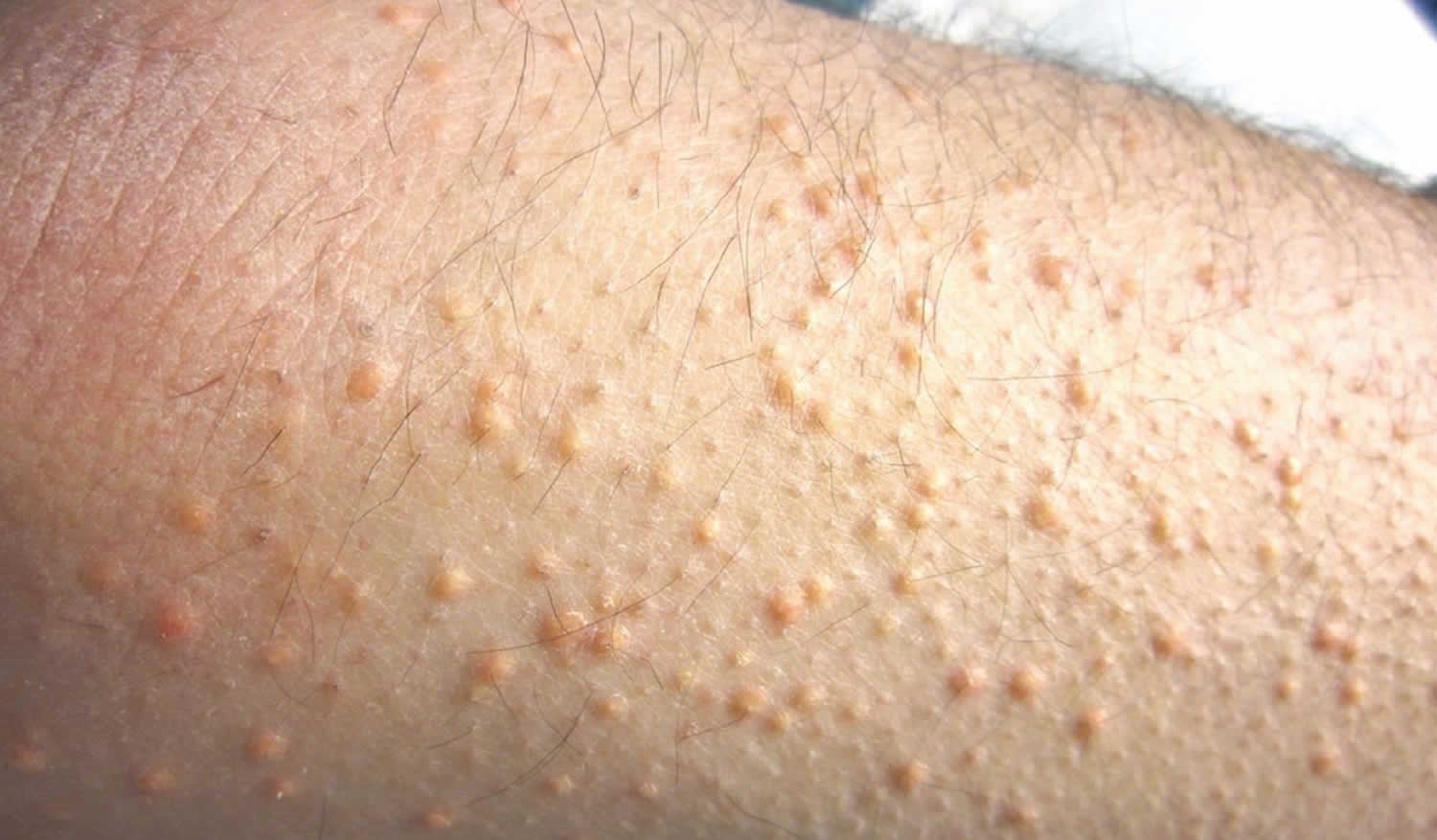Eruptive xanthoma
Eruptive xanthoma is also called eruptive xanthomatosis, are cutaneous manifestations of extreme hypertriglyceridemia (high concentrations of plasma triglycerides) in which lipids accumulate in large foam cells within the skin. Eruptive xanthoma presents as crops of small pink or red-yellow papules which may be tender and are often itchy. They classically present as crops of 1- to 4-mm yellow-orange papules. Eruptive xanthoma occurs as a result of high concentrations of plasma triglycerides (hypertriglyceridemia). Many patients have uncontrolled diabetes mellitus. Eruptive xanthoma most commonly arise over the buttocks, shoulders, arms and legs but may occur all over the body. Rarely the face and inside of the mouth may be affected. Eruptive xanthoma lesions may resolve spontaneously over a few weeks.
A xanthoma is a skin lesion caused by the accumulation of fat in macrophage immune cells in the skin and more rarely in the layer of fat under the skin. The xanthomas usually disappear when the underlying condition is treated.
Some types of xanthoma are indicative of lipid metabolism disorders (e.g. hyperlipidemia or high blood fats), where they may be associated with increased risk of coronary artery heart disease and occasionally with pancreatitis.
Figure 1. Eruptive xanthoma
Eruptive xanthoma causes
Eruptive xanthomatosis is a rare skin condition caused by excessively high serum triglyceride levels that occur with hyperlipidemia syndromes (ie., Fredrickson–Levy types I, IV and V) or with diabetes mellitus, hypothyroidism, obesity, pancreatitis, nephrotic syndrome, cholestatic liver disease, dysglobulinemia and as an adverse effect of using certain medications (e.g., estrogens, corticosteroids, systemic retinoid agents) 1. Eruptive xanthomatosis can occur in people with poorly-controlled diabetes who have very high triglycerides and high cholesterol.
Cholesterol and triglycerides are types of fats that naturally occur in your blood. High levels increase the risk for heart disease and other health problems.
When diabetes is not well-controlled, there is less insulin in the body. Low insulin levels makes it harder for the body to break down fats in the blood. This increases the level of fats in the blood. The extra fat can collect under the skin to form small bumps (lesions).
Eruptive xanthomatosis prevention
Control of blood fats and blood sugar can help prevent eruptive xanthomatosis. Follow your doctor’s treatment recommendations.
Eruptive xanthomatosis symptoms
Eruptive xanthomas are characterized by the sudden appearance of grouped, yellow–red papules scattered over the trunk, arms, legs and buttocks 2. The skin bumps may vary in color from yellow, orange-yellow, red-yellow, to red. A small red halo may form around the bump. The bumps are:
- Pea-sized
- Waxy
- Firm
While harmless, the bumps may be itchy and tender. They tend to appear on the:
- Buttocks
- Shoulders
- Arms
- Thighs
- Legs.
Eruptive xanthomatosis complications
If not treated, high triglyceride levels can lead to pancreatitis.
Eruptive xanthomatosis diagnosis
Your health care provider will take your medical history and examine your skin. You may have the following blood tests:
- Blood test for cholesterol and triglycerides
- Blood sugar test for diabetes
- Pancreatic function test
A skin biopsy may be done to help diagnose the condition. In eruptive xanthoma, the dermis contains a dense population of foamy histiocytes (histiocytes filled with lipid material as well as extracellular lipid. There is often an associated acute and chronic inflammatory response.
Eruptive xanthomatosis treatment
Treatment involves management of the underlying condition, whereby lesions resolve within weeks to months 3. Patients should also be counseled on lifestyle changes, including weight control, adopting a low-fat diet, exercising and quitting smoking 3.
Treatment for eruptive xanthomatosis involves lowering:
- Blood fats
- Blood sugar
Your health care provider will ask you to make changes in your lifestyle and diet. This can help lower high blood fats.
If you have diabetes, your doctor will ask you to manage your blood sugar through diet, exercise, and medicines.
If lifestyle changes do not work, your doctor may ask you to take medicines to help lower blood fat levels, such as:
- Statins
- Fibrates
- Lipid-lowering antioxidants
- Niacin
- Bile acid resins
The skin bumps go away by themselves after few weeks. They clear once the blood sugar and fat levels are under control.
References- Robson KJ, Piette WW. Cutaneous manifestations of systemic diseases. Med Clin North Am 1998;82:1359–79.
- Parker F. Xanthomas and hyperlipidemias. J Am Acad Dermatol 1985;13:1–30.
- National Cholesterol Education Program (NCEP) Expert Panel on Detection, Evaluation, and Treatment of High Blood Cholesterol in Adults (Adult Treatment Panel III). Third report of the National Cholesterol Education Program (NCEP) Expert Panel on Detection, Evaluation, and Treatment of High Blood Cholesterol in Adults (Adult Treatment Panel III) final report. Circulation 2002;106:3143–421.






